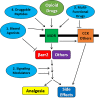Novel Molecular Strategies and Targets for Opioid Drug Discovery for the Treatment of Chronic Pain
- PMID: 28356897
- PMCID: PMC5369049
Novel Molecular Strategies and Targets for Opioid Drug Discovery for the Treatment of Chronic Pain
Abstract
Opioid drugs like morphine and fentanyl are the gold standard for treating moderate to severe acute and chronic pain. However, opioid drug use can be limited by serious side effects, including constipation, tolerance, respiratory suppression, and addiction. For more than 100 years, we have tried to develop opioids that decrease or eliminate these liabilities, with little success. Recent advances in understanding opioid receptor signal transduction have suggested new possibilities to activate the opioid receptors to cause analgesia, while reducing or eliminating unwanted side effects. These new approaches include designing functionally selective ligands, which activate desired signaling cascades while avoiding signaling cascades that are thought to provoke side effects. It may also be possible to directly modulate downstream signaling through the use of selective activators and inhibitors. Separate from downstream signal transduction, it has also been found that when the opioid system is stimulated, various negative feedback systems are upregulated to compensate, which can drive side effects. This has led to the development of multi-functional molecules that simultaneously activate the opioid receptor while blocking various negative feedback receptor systems including cholecystokinin and neurokinin-1. Other novel approaches include targeting heterodimers of the opioid and other receptor systems which may drive side effects, and making endogenous opioid peptides druggable, which may also reduce opioid mediated side effects. Taken together, these advances in our molecular understanding provide a path forward to break the barrier in producing an opioid with reduced or eliminated side effects, especially addiction, which may provide relief for millions of patients.
Keywords: Chronic Pain; Drug Discovery; Functional Selectivity; Novel Strategies; Novel Targets; Opioid.
Figures

Similar articles
-
[Pain inhibition by opioids-new concepts].Anaesthesist. 2019 Feb;68(2):97-103. doi: 10.1007/s00101-018-0528-0. Anaesthesist. 2019. PMID: 30645691 Review. German.
-
Responsible, Safe, and Effective Prescription of Opioids for Chronic Non-Cancer Pain: American Society of Interventional Pain Physicians (ASIPP) Guidelines.Pain Physician. 2017 Feb;20(2S):S3-S92. Pain Physician. 2017. PMID: 28226332
-
New concepts in opioid analgesia.Expert Opin Investig Drugs. 2018 Oct;27(10):765-775. doi: 10.1080/13543784.2018.1516204. Epub 2018 Sep 7. Expert Opin Investig Drugs. 2018. PMID: 30148648 Review.
-
Opioid analgesia: recent developments.Curr Opin Support Palliat Care. 2020 Jun;14(2):112-117. doi: 10.1097/SPC.0000000000000495. Curr Opin Support Palliat Care. 2020. PMID: 32304400 Review.
-
[Pain inhibition by opioids-new concepts].Schmerz. 2019 Aug;33(4):295-302. doi: 10.1007/s00482-019-0386-y. Schmerz. 2019. PMID: 31222410 Review. German.
Cited by
-
Finding the Perfect Fit: Conformational Biosensors to Determine the Efficacy of GPCR Ligands.ACS Pharmacol Transl Sci. 2022 Aug 14;5(9):694-709. doi: 10.1021/acsptsci.1c00256. eCollection 2022 Sep 9. ACS Pharmacol Transl Sci. 2022. PMID: 36110374 Free PMC article. Review.
-
Mu-opioid Receptor (MOR) Biased Agonists Induce Biphasic Dose-dependent Hyperalgesia and Analgesia, and Hyperalgesic Priming in the Rat.Neuroscience. 2018 Dec 1;394:60-71. doi: 10.1016/j.neuroscience.2018.10.015. Epub 2018 Oct 17. Neuroscience. 2018. PMID: 30342200 Free PMC article.
-
Allosteric Modulator Leads Hiding in Plain Site: Developing Peptide and Peptidomimetics as GPCR Allosteric Modulators.Front Chem. 2021 Oct 7;9:671483. doi: 10.3389/fchem.2021.671483. eCollection 2021. Front Chem. 2021. PMID: 34692635 Free PMC article. Review.
-
Editorial: Novel Molecular Targets for the Treatment of Pain.Front Mol Neurosci. 2020 Dec 11;13:625714. doi: 10.3389/fnmol.2020.625714. eCollection 2020. Front Mol Neurosci. 2020. PMID: 33424551 Free PMC article. No abstract available.
-
Comprehensive molecular pharmacology screening reveals potential new receptor interactions for clinically relevant opioids.PLoS One. 2019 Jun 6;14(6):e0217371. doi: 10.1371/journal.pone.0217371. eCollection 2019. PLoS One. 2019. PMID: 31170174 Free PMC article.
References
-
- Gaskin DJ, Richard P. The economic costs of pain in the United States. J Pain. 2012;13(8):715–724. - PubMed
-
- Breivik H, Cherny N, Collett B. et al. Cancer-related pain: a pan-European survey of prevalence, treatment, and patient attitudes. Ann Oncol. 2009;20(8):1420–1433. - PubMed
-
- National Institute for Health and Clinical Excellence: Guidance. Cardiff (UK): National Collaborating Centre for Cancer (UK); 2012. Opioids in Palliative Care: Safe and Effective Prescribing of Strong Opioids for Pain in Palliative Care of Adults. - PubMed
-
- Kroenke K, Krebs EE, Bair MJ. Pharmacotherapy of chronic pain: a synthesis of recommendations from systematic reviews. Gen Hosp Psychiatry. 2009;31(3):206–219. - PubMed
-
- Ossipov MH, Lai J, Malan TP Jr.. et al. Spinal and supraspinal mechanisms of neuropathic pain. Ann N Y Acad Sci. 2000;909:12–24. - PubMed
Publication types
MeSH terms
Substances
LinkOut - more resources
Full Text Sources
Other Literature Sources
Medical
